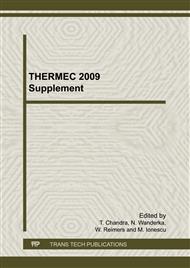p.118
p.124
p.130
p.136
p.142
p.147
p.153
p.159
p.165
The Evolution of Transversal Surface Defects in the Axisymmetric Drawing of Copper Bars
Abstract:
Surface defects are an inevitable characteristic of the raw material employed in the drawing of copper wires. These defects may cause problems in the processing of the material, both during the drawing down to wires and in the final manufacturing of artifacts with the produced wire. The literature reports few analyses covering the importance of these initial defects, as well as concerning their evolution or eventual healing during the drawing. The present paper presents such an analysis for a 12.7 mm diameter copper bar displaying artificial defects 1mm wide and 0.3mm deep. Low angle drawing led to the almost complete healing of the defect after three drawing passes with a 10% reduction of area each. The use of a high semi-angle die led to a completely different situation, where no such defect healing was observed.
Info:
Periodical:
Pages:
142-146
Citation:
Online since:
January 2010
Keywords:
Price:
Сopyright:
© 2010 Trans Tech Publications Ltd. All Rights Reserved
Share:
Citation:


